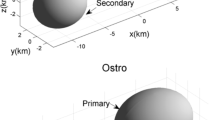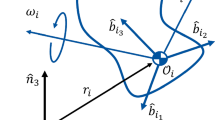Abstract
This paper investigates the equilibria and their stabilities in the doubly synchronous binary asteroid systems, which are modelled as the two tri-axial ellipsoids with various shape and system parameters. Particularly, the in uences of shape and system parameters on equilibria are discussed analytically. Firstly, the geometrical models of doubly synchronous binary asteroid systems are established. The dual second degree and order gravity field is employed to approximate the gravitational potential of the system. Six shape and system parameters are defined. Then, based on the linearized perturbation equations, the explicit expressions of the offsets of equilibria in doubly synchronous systems are derived, which clearly illustrate the relationship between the distribution of equilibria and the variations of shape parameters. Further, the approximate expressions are applied to estimate the offsets of equilibria due to parameter errors, respectively. Finally, in order to have a better insight into the equilibriaum structure, the stabilities of equilibria under different system parameters are investigated. In particular, critical regions of triangular equilibria are calculated and the role of the relative distance on the stability is discussed in detail. This study could provide a preliminary analysis of equilibria for the mission design in doubly synchronous binary asteroid systems.
Similar content being viewed by others
Change history
11 February 2022
A Correction to this paper has been published: https://doi.org/10.1007/s42064-022-0136-2
References
Margot, J. L., Nolan, M. C., Benner, L. A. M., Ostro, S. J., Jurgens, R. F., Giorgini, J. D., Slade, M. A., Campbell, D. B. Binary asteroids in the near-Earth object population. Science, 2002, 296(5572): 1445–1448.
Pravec, P., Harris, A. W. Binary asteroid population: 1. Angular momentum content. Icarus, 2007, 190(1): 250–259.
Walsh, K. J., Richardson, D. C., Michel, P. Rotational breakup as the origin of small binary asteroids. Nature, 2008, 454(7201): 188–191.
Jacobson, S. A., Scheeres, D. J. Dynamics of rotationally fissioned asteroids: Source of observed small asteroid systems. Icarus, 2011, 214(1): 161–178.
Michel, P., Barucci, M. A., Cheng, A. F., Böhnhardt, H., Brucato, J. R., Dotto, E., Ehrenfreund, P., Franchi, I. A., Green, S. F., Lara, L.-M., Marty, B.; Koschny, D., Agnolon, D. MarcoPolo-R: Near-Earth asteroid sample return mission selected for the assessment study phase of the ESA program cosmic vison. Acta Astronautica, 2014, 93(1): 530–538.
Cheng, A. F., Atchison, J., Kantsiper, B., Rivkin, A. S., Stickle, A., Reed, C., Galvez, A., Carnelli, I., Michel, P., Ulamec, S. Asteroid impact and de ection assessment mission. Acta Astronautica, 2015, 115: 262–269.
Bellerose, J., Scheeres, D. J. General dynamics in the restricted full three body problem. Acta Astronautica, 2008, 62(10-11): 563–576.
Wang, X., Jiang, Y., Gong, S. Analysis of the potential field and equilibrium points of irregular-shaped minor celestial bodies. Astrophysics and Space Science, 2014, 353(1): 105–121.
Jiang, Y., Baoyin, H., Li, J., Li, H. Orbits and manifolds near the equilibrium points around a rotating asteroid. Astrophysics and Space Science, 2014, 349(1): 83–106.
Baoyin, H., Mcinnes, C. R. Trajectories to and from the Lagrange points and the primary body surfaces. Journal of Guidance, Control, and Dynamics, 2006, 29(4): 998–1003.
Yang, H., Gong, S., Baoyin, H. Two-impulse transfer orbits connecting equilibrium points of irregular-shaped asteroids. Astrophysics and Space Science, 2015, 357: 66.
Bellerose, J., Scheeres, D. J. Stability of equilibrium points in the restricted full three-body problem. Acta Astronautica, 2007, 60(3): 141–152.
Arredondo, J. A., Guo, J., Stoica, C., Tamayo, C. On the restricted three body problem with oblate primaries. Astrophysics and Space Science, 2012, 341(2): 315–322.
Woo, P., Misra, A. K. Equilibrium points in the full three-body problem. Acta Astronautica, 2014, 99: 158–165.
Woo, P., Misra, A. K. Bounded trajectories of a spacecraft near an equilibrium point of a binary asteroid system. Acta Astronautica, 2014, 110: 313–323.
Woo, P., Misra, A. K. Control of spacecraft trajectories near collinear equilibrium points of binary asteroid systems. Journal of Guidance, Control, and Dynamics, 2015, 39(4): 979–984.
Bosanac, N., Howell, K. C., Fischbach, E. Stability of orbits near large mass ratio binary systems. Celestial Mechanics and Dynamical Astronomy, 2015, 122(1): 27–52.
Scheeres, D. J. Stability in the full two-body problem. In: Modern Celestial Mechanics: From Theory to Applications. Celletti, A., Ferraz-Mello, S., Henrard, J. Eds. Dordrecht: Springer, 2002: 155–169.
Scheeres, D. J. Stability of relative equilibria in the full two-body problem. Annals of the New York Academy of Sciences, 2004, 1017: 81–94.
Gabern, F., Koon, W. S., Marsden, J. E. Parking a spacecraft near an asteroid pair. Journal of Guidance, Control, and Dynamics, 2006, 29(3): 544–553.
Jain, R., Sinha, D. Stability and regions of motion in the restricted three-body problem when both the primaries are finite straight segments. Astrophysics and Space Science, 2014, 351(1): 87–100.
Shang, H., Wu, X., Cui, P. Periodic orbits in the doubly synchronous binary asteroid systems and their applications in space missions. Astrophysics and Space Science, 2015, 355(1): 69–87.
Descamps, P., Marchis, F., Pollock, J., Berthier, J., Vachier, F., Birlan, M., Kaasalainen, M., Harris, A. W., Wong, M. H., Romanishin, W. J., Cooper, E. M., Kettner, K. A., Wiggins, P., Kryszczynska, A., Polinska, M., Coliac, J.-F., Devyatkin, A., Verestchagina, I., Gorshanov, D. New determination of the size and bulk density of the binary Asteroid 22 Kalliope from observations of mutual eclipses. Icarus, 2008, 196(2): 578–600.
Scheeres, D. J. Stability of the planar full 2-body problem. Celestial Mechanics and Dynamical Astronomy, 2009, 104(1-2): 103–128.
Scheeres, D. J. Orbital Motion in Strongly Perturbed Environments: Applications to Asteroid, Comet and Planetary Satellite Orbiters. Berlin, Heidelberg: Springer, 2012.
Scheeres, D. J. Orbital mechanics about small bodies. Acta Astronautica, 2012, 72: 1–14.
Wiesel, W. E. Stable orbits about the Martian moons. Journal of Guidance, Control, and Dynamics, 2015, 16(3): 434–440.
Scheeres, D. J. Changes in rotational angular momentum due to gravitational interactions between two finite bodies. Celestial Mechanics and Dynamical Astronomy, 2001, 81(1-2): 39–44.
Scheeres, D. J., Fahnestock, E. G., Ostro, S. J., Margot, J.-L., Benner, L. A. M., Broschart, S. B., Bellerose, J., Giorgini, J. D., Nolan, M. C., Magri, C., Pravec, P., Scheirich, P., Rose, R., Jurgens, R. F., De Jong, E. M., Suzuki, S. Dynamical configuration of binary near-Earth asteroid (66391) 1999 KW4. Science, 2006, 314(5803): 1280–1283.
Acknowledgements
This work was supported by the Chang Jiang Scholars Program and the National Natural Science Foundation of China (Grant No. 11572038).
Author information
Authors and Affiliations
Corresponding author
Additional information
Xiangyu Li is a Ph.D. candidate in Beijing Institute of Technology. His major is the orbit dynamics in the vicinity of small bodies.
Dong Qiao is a professor in Beijing Institute of Technology. He was a visiting scholar in University of Strathclyde in 2014 and was selected as the Young Chang Jiang Scholar in 2016. He is mainly engaged in the research of orbit dynamics and control in deep space.
M. A. Barucci is the senior astronomer of LESIA, the Paris Observatory. She mainly works on celestial mechanics, astrophysics, and space science. She is credited by the Minor Planet Center with a total of 3 minor planet discoveries in 1984 and 1985. She currently focuses on ESA Asteroid Sample Return Mission and engages in the Cosmic Vision M5 Program.
Rights and permissions
About this article
Cite this article
Li, X., Qiao, D. & Barucci, M.A. Analysis of equilibria in the doubly synchronous binary asteroid systems concerned with non-spherical shape. Astrodyn 2, 133–146 (2018). https://doi.org/10.1007/s42064-017-0016-3
Received:
Accepted:
Published:
Issue Date:
DOI: https://doi.org/10.1007/s42064-017-0016-3




